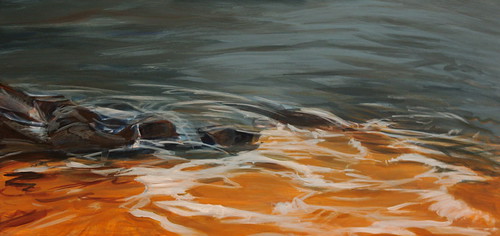From my first days painting I have copied 'masters', be they old or contemporary, to learn how to handle my paint. And now when I'm having problems, need inspiration, or just need exercises to get started on a day, I will still do quick tonal studies of master paintings. It's a great habit to have. I've even spent hours in the National Gallery doing sketches of just the background landscapes of Dutch paintings - who cares about the foreground boats, buildings and animals, the things they have going on in the background are amazing!
For my problem "Storm" painting (see my previous post) I pulled out two of my favourite seascape books to analyse what other painters have done to capture the mood of rough seas.
 Winslow Homer: Poet of the Sea
Winslow Homer: Poet of the SeaFrom the exhibition at Dulwich Picture Gallery in 2006.
The catalogue of the exhibition includes images of drawings, studies, watercolours and large-scale oil paintings. Some of Homer's work didn't quite connect with me, mostly the more nostalgic type images, but others were incredibly strong with the sea itself bordering on abstract paintwork. So I flip through it often to see how he captured those moments of movement and drama. (I haven't yet found a book with reproductions of Turner that I'm happy with, so for now I rely on postcards and visits to the National Gallery or Tate Britain to see those.)
 Art for the Nation: The Oil Paintings Collection of the National Maritime Museum
Art for the Nation: The Oil Paintings Collection of the National Maritime MuseumEven though I live next door to it I had to have the catalogue of the NMM's collection in my grubby little hands for any given moment! This book covers themes from the whole collection it isn't just traditional seascape - the museum also holds important materials relevent to periods in maritime history such as shipping, slavery, colonization, and war. But having a book with such a wealth of sea-related artwork is necessary for me as a marine painter. Like with the Dutch paintings (and some of these are Dutch too of course) I can flip through and sketch the backgrounds, the use of contrast in the sky or the lines that break up the canvas. I'd highly recommend this for anyone interested in painting seas or ships.
So what are you favourite books for water or sea references? Or do have another important resource for working out your painting problems?
I'm still stuck in that storm, but will get back to you in March...
![Reblog this post [with Zemanta]](http://img.zemanta.com/reblog_e.png?x-id=bae457bb-87b4-4700-972c-9d54e626cc3a)



![Reblog this post [with Zemanta]](http://img.zemanta.com/reblog_e.png?x-id=8ebd0789-fb7e-453c-b893-7b7a332e3810)



































